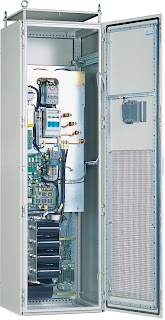Active Harmonic Filters (AHF) are power quality devices that monitor the nonlinear load and dynamically provide controlled current injection, which cancels out the harmonic currents in the electrical system. They also correct poor displacement power factor (DPF) by compensating the system’s reactive current. The concept applied is relatively old, but the lack of effective methods hampered its development for a number of years. Presently, the widespread use of Insulated Gate Bipolar Transistors (IGBT) and the availability of Digital Signal Processing (DSP) components are paving the way for the emergence of active harmonic filters.
Generally, active harmonic filters are installed at any point on a low voltage AC network. They are commonly thought to be very expensive, which is one of the main reasons why demand remains lower than their passive counterparts. Nevertheless, understanding what a mitigating device does to improve the power quality, as well as its benefits and drawbacks, provide optimized solutions for the end-user.
An active harmonic filter is similar to a harmonics current generator. It uses power electronics to measure the harmonics produced by nonlinear loads. Then, it will precisely inject an opposite phase-shifted harmonic current of the same amplitude. As a result, the current supplied by the power source will remain sinusoidal since the harmonics will negate each other. Thus, distortion is reduced to less than 5% THD, meeting IEEE 519 Standards.
 |
| Active Harmonic Filter Correction Diagram |
Furthermore, the AHF’s design allows it to:
· Remove all harmonic currents from nonlinear loads
· Compensate reactive power factor (PF) of lagging loads
· Act as a damping resistor to avoid harmonic resonance
Types
1. Shunt filter
It is in parallel with the AC line and is used to remove harmonic distortions caused by nonlinear loads. Therefore, this type of filter is independent on the load or electrical AC system characteristics. Subsequently, it needs only to be sized for the harmonic current drawn by the nonlinear loads.
2. Series filter
It is connected in series with the AC distribution network and functions to offset harmonic distortions that are present in the electrical system. This solution is technically similar to power line conditioners and should be sized for the total load rating.
3. Hybrid filter
This is a combination of an active and a passive filter, and could either of the shunt or series type. In special cases, it may be a cost-effective solution. Here, the passive filter performs the basic filtering and the active filter, through its dynamic and precise method, removes the other harmonics.
Moreover, active harmonic filters can also be either of the following:
1. Three-wire
They are large and commonly installed in variable speed drives and other such applications, which have a large number of nonlinear loads.
2. Four-wire
These filters are used to eliminate harmonics that are generated by switched-mode power supplies (SMPS) and Information Technology equipment. They have the capability to filter triplen harmonics in the neutral conductor.
Applications
Active harmonics filters can be applied to a single or group of nonlinear loads. The nonlinear loads can be uninterruptible power supplies (UPS), variable frequency drives (VFD) and DC motor speed controls. Other AHF applications are when:
· PF correction in harmonic-rich systems can’t be suitably achieved by capacitors.
· Input line reactors are used to reduce the total harmonics distortion of nonlinear loads.
· Thyristor rectifiers are used, and both PF and harmonics correction are required.
· Six-pulse rectifiers are employed in UPS, VFD, DC drives and DC power supplies.
· Emergency power and distributed generation are present in the electrical system.
Active versus Passive
An active harmonic filter has several advantages over a passive type in terms of technical performance. To name a few:
a. AHF mitigates a full range of harmonic order, and will not create a resonance condition with other existing equipment. On the other hand, passive harmonic filters are designed to trap just one or a few harmonic orders.
b. Minimal analysis is required prior to installation. With other harmonic mitigation solutions, expensive and time-consuming data collection, power quality surveys and software generated studies are normally needed.
c. Active harmonic filters do not cause leading PF at any time and is not affected even if harmonics are present while performing PF correction.
d. For shunt active filters, sizing is independent of the total load current and is based on the amount of harmonic current only. Thus, capital costs are lowered as it can be installed at a reduced ampere rating.
e. They can be conveniently added in parallel with other active filters to accommodate future facility expansions. This saves valuable time for installation which eliminates downtime in operation.
f. It functions the same, regardless of the power source – utility, on-site power generator or even the output of a UPS or flywheel.
g. AHFs may provide other benefits such as voltage flicker reduction, load balancing and voltage regulation.
References:
Akagi, H. (2005). Active Harmonic Filters. IEEE Paper.
Gougler, C. and Johnson, J. (1999). Parallel Active Harmonic Filters Economical Viable Technology.



No comments:
Post a Comment